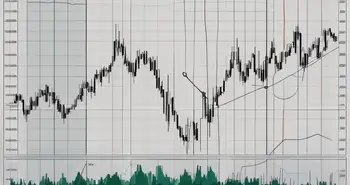Random Walk Theory: Does It Really Explain Stock Market Behavior?

Random Walk Theory is a captivating concept that has influenced both the fields of finance and applied mathematics. At its core, it suggests that the future path of a variable, such as stock prices, is significantly influenced by its past behavior, but with a significant element of randomness. This theory posits that price changes are independent of each other, making market predictions exceedingly challenging.
When I first encountered Random Walk Theory in my studies, it struck me how simple the idea seemed yet how profound its implications were. It had an air of mystery—how could something so unpredictable offer a structured way to think about financial markets? This initial curiosity led me down a path of exploration that deepened my understanding of market dynamics.
The Basic Concept of Random Walk Theory
The basic premise of Random Walk Theory is founded on the notion that stock price movements are random and cannot be predicted accurately. This is often illustrated through the metaphor of a drunken man loitering on a street. While his past steps do have an influence on where he can go, each new step is ultimately random.
This randomness highlights two critical aspects: first, it challenges the idea that stock market trends can be easily identified, and second, it suggests that trying to predict market movements can lead to significant financial losses. Early in my career, I attempted to rely heavily on technical analysis to predict stock prices, only to realize that I was often wrong. This was a turning point, leading me to appreciate the value of understanding randomness in market behaviors.
The Origin and History of Random Walk Theory
The roots of Random Walk Theory can be traced back to French mathematician Louis Bachelier, who first proposed the idea in his 1900 dissertation. However, it gained significant traction in the mid-20th century, thanks to economists such as Eugene Fama. Fama's work laid the foundation for what we now call the Efficient Market Hypothesis (EMH), positing that all known information is already reflected in stock prices.
This historical context gives us insight into how deeply interconnected the fields of economics, probability, and finance are. Each discovery built upon another, creating a rich tapestry that continues to evolve to this day.
The Mathematical Foundation of Random Walk Theory
To appreciate Random Walk Theory fully, a basic understanding of its mathematical underpinnings is essential. The theory employs concepts from probability theory and statistical analysis to model the random movements of stock prices.
The fascinating interplay between mathematics and real-world finance is a theme I find endlessly intriguing. Each time I analyze market data, I am reminded of how mathematical tools lend structure to otherwise chaotic environments.
Probability and Random Walk Theory
Probability is the backbone of Random Walk Theory. In financial markets, each movement is considered a random event, and the likelihood of each outcome can be mathematically quantified. By utilizing models and simulations, we can visualize how an asset’s price might evolve over time, albeit unpredictably.
Understanding probability has given me an advantage in my analyses, allowing for a more nuanced interpretation of market data. Instead of relying solely on trends, I incorporate stochastic models that embrace uncertainty, which often leads to more successful investment strategies over time.
Statistical Analysis in Random Walk Theory
Statistical techniques provide the tools to analyze the volatility and distribution of stock returns. Measures such as standard deviation, mean, and variance enable investors to assess risk and make more informed decisions. Statistical analysis also aids in validating the random walk hypothesis, providing empirical evidence to back theoretical claims.
A particular experience comes to mind—during a financial crisis, I employed statistical analysis to evaluate market volatility. This approach led me to adjust my portfolio swiftly, protecting my investments when most were panicking.
Different Types of Random Walks
Not all random walks are created equal; distinguishing between various types offers deeper insight into market behavior. Here, we explore two primary categories: simple and non-simple random walks.
Simple Random Walk
A simple random walk represents a basic model where the future position depends only on the current position and an unpredictable step taken. In this model, financial prices move either up or down by a fixed amount with equal probability.
This model serves as a foundational building block in both academic research and practical applications, helping to understand more complex financial phenomena. My early grasp of this model prepared me for more advanced theories and led to successful financial modeling practices.
Non-Simple Random Walk
Non-simple random walks are characterized by varying step sizes and probabilities. These may incorporate factors such as trends or market behavior tied to investor psychology. This complexity often more accurately mirrors real-market conditions, where certainty is scarce.
This realization prompted me to develop models incorporating various external variables, which have proven valuable in my analytical endeavors and in providing a robust understanding of market risks.
The Implications of Random Walk Theory in Finance
The repercussions of Random Walk Theory extend beyond theoretical musings; they shape financial strategies and investment philosophies around the globe. Understanding its implications allows investors to navigate the unpredictability of the markets more effectively.
Efficient Market Hypothesis and Random Walk Theory
The Efficient Market Hypothesis states that asset prices reflect all available information. Essentially, if markets are efficient, price changes should follow a random walk, making it nearly impossible for investors to consistently outperform the market.
This realization has incentivized investment strategies rooted in index funds and passive management. My journey in finance shifted towards this approach as I recognized the futility of trying to time the market—a lesson that I see many new investors struggle with.
Predicting Stock Market Trends Using Random Walk Theory
Though predicting trends may seem futile under the random walk principle, understanding price movements can still offer valuable insights. By adopting a probabilistic approach, investors can identify potential ranges for price movements, allowing for better-informed investment decisions.
A colleague once explained to me the importance of setting realistic expectations when investing, rather than chasing unrealistic gains. This mindset has changed my perspective and allowed me to remain disciplined during market fluctuations.
Criticisms and Limitations of Random Walk Theory
While Random Walk Theory provides a solid theoretical framework, it is not without its criticisms. Many argue that it oversimplifies the complexities of financial markets, overlooking the role of human behavior and external factors.
Arguments Against Random Walk Theory
Critics highlight market anomalies, such as momentum or mean reversion, which suggest that price movements are not entirely random. Behavioral finance, which examines how psychological factors influence investors, also presents strong arguments against the theory.
This critique resonates with my experience; I have often observed trends fueled by collective human emotions rather than pure randomness, complicating my investment decisions. A balanced perspective acknowledges both randomness and human behavior in market analysis.
The Impact of Market Anomalies on Random Walk Theory
Market anomalies challenge the efficiency imposed by Random Walk Theory. Situations where stocks exhibit price behavior contrary to efficient market principles suggest that there are underlying patterns worthy of exploration.
My journey into trading has often involved recognizing these anomalies. Each experience taught me the value of adaptability and the necessity of blending different analytical approaches to refine my techniques.
FAQ
- What is Random Walk Theory?
Random Walk Theory suggests that stock price movements are largely unpredictable and follow a pattern similar to a random walk.
- Who originated Random Walk Theory?
French mathematician Louis Bachelier introduced the idea in 1900, laying the groundwork for modern financial theories.
- What are the practical implications of Random Walk Theory in finance?
Its principles underpin the Efficient Market Hypothesis and guide investment strategies, particularly passive management.
- Why do critics argue against Random Walk Theory?
Critics point out that it oversimplifies market complexities and overlooks behavioral influences and market anomalies.
While the Random Walk Theory suggests that predicting stock market trends is a challenge, Morpher offers a revolutionary trading platform that embraces the unpredictability of financial markets. With its zero-fee structure, infinite liquidity, and the ability to trade across a multitude of asset classes, Morpher is ideal for both seasoned traders and newcomers looking to navigate the financial world with ease. Whether you're interested in fractional investing, short selling without interest fees, or leveraging up to 10x, Morpher provides a unique and flexible trading experience on the Ethereum Blockchain. Embrace the future of investing with Morpher and Sign Up and Get Your Free Sign Up Bonus today.

Disclaimer: All investments involve risk, and the past performance of a security, industry, sector, market, financial product, trading strategy, or individual’s trading does not guarantee future results or returns. Investors are fully responsible for any investment decisions they make. Such decisions should be based solely on an evaluation of their financial circumstances, investment objectives, risk tolerance, and liquidity needs. This post does not constitute investment advice.

Painless trading for everyone
Hundreds of markets all in one place - Apple, Bitcoin, Gold, Watches, NFTs, Sneakers and so much more.

Painless trading for everyone
Hundreds of markets all in one place - Apple, Bitcoin, Gold, Watches, NFTs, Sneakers and so much more.









